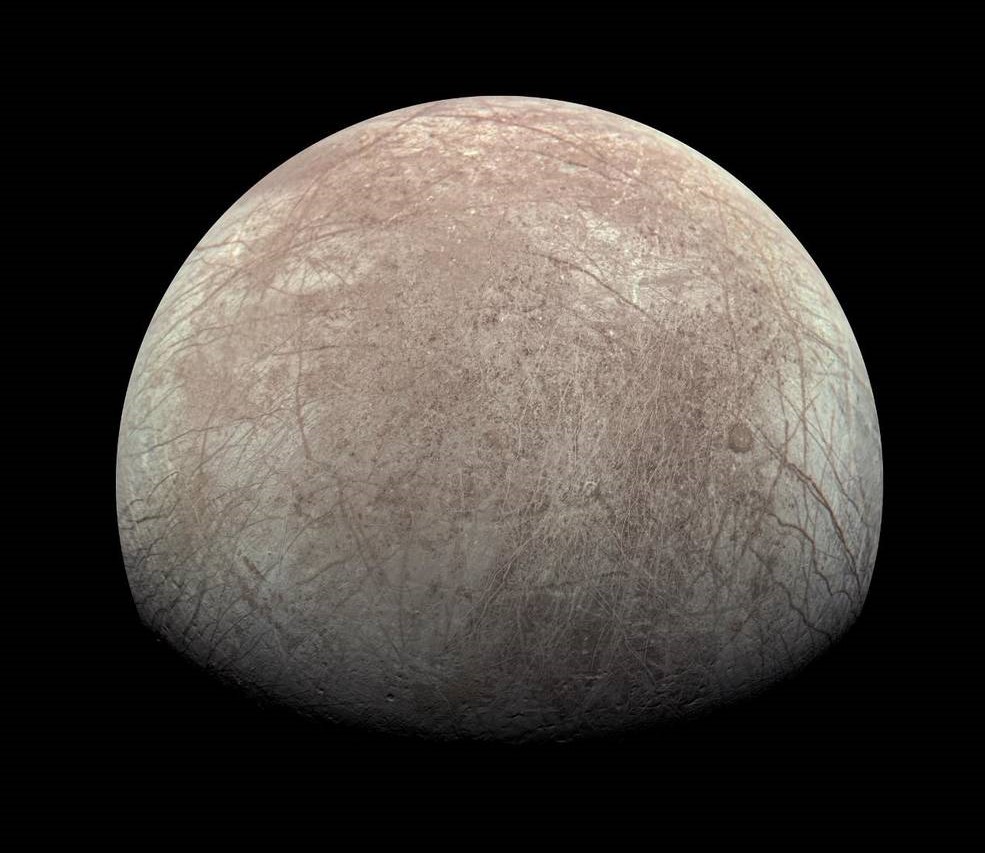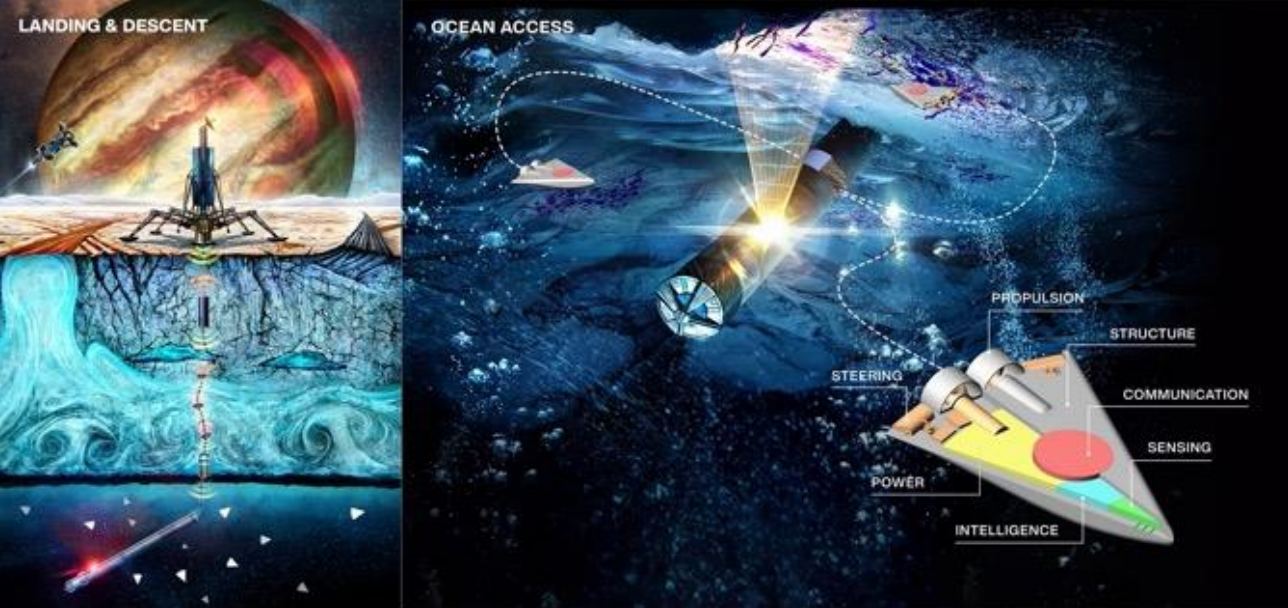Enceladus is blasting water into space from the jets at its southern pole. This makes it the ideal place to send a dedicated mission, flying the spacecraft through the plumes with life-detection instruments s. A new study suggests that a spacecraft must proceed carefully through the plumes, keeping its speed below 4.2 km/second (2,236 miles per hour). Using a specialized, custom-built aerosol impact spectrometer at these speeds will allow fragile amino acids to be captured by the spacecraft’s sample collector. Any faster, they’ll shatter, providing inclusive results.
Continue reading “Fly Slowly Through Enceladus' Plumes to Detect Life”Europa Clipper Could Help Discover if Jupiter's Moon is Habitable
Since 1979, when the Voyager probes flew past Jupiter and its system of moons, scientists have speculated about the possibility of life within Europa. Based on planetary modeling, Europa is believed to be differentiated between a rocky and metallic core, an icy crust and mantle, and a liquid-water ocean that could be 100 to 200 km (62 to 124 mi) deep. Scientists theorize that this ocean is maintained by tidal flexing, where interaction with Jupiter’s powerful gravitational field leads to geological activity in Europa’s core and hydrothermal vents at the core-mantle boundary.
Investigating the potential habitability of Europa is the main purpose of NASA’s Europa Clipper mission, which will launch on October 10th, 2024, and arrive around Jupiter in April 2030. However, this presents a challenge for astrobiologists since the habitability of Europa is dependent on many interrelated parameters that require collaborative investigation. In a recent paper, a team of NASA-led researchers reviewed the objectives of the Europa Clipper mission and anticipated what it could reveal regarding the moon’s interior, composition, and geology.
Continue reading “Europa Clipper Could Help Discover if Jupiter's Moon is Habitable”Should We Send Humans to Europa?

Universe Today recently examined the potential for sending humans to the planet Venus despite its extremely harsh surface conditions. But while a human mission to the clouds of Venus could be feasible given the environmental conditions are much more Earth-like, a human mission to the second planet from the Sun could be (at minimum) decades away. With NASA sending humans back to the Moon in the next few years, and hopefully to Mars, what if we could send humans to another planetary body worth exploring, though it could have its own harsh environmental conditions, as well? What about Jupiter’s icy moon, Europa? It has a massive interior liquid ocean that could harbor life, and NASA is currently scheduled to launch its Europa Clipper spacecraft to this small moon in October 2024, arriving at Jupiter in April 2030. Therefore, given the exploration potential, should we send humans to Europa?
Continue reading “Should We Send Humans to Europa?”The JWST Just Found Carbon on Europa, Boosting the Moon’s Potential Habitability

Most planets and moons in the Solar System are clearly dead and totally unsuitable for life. Earth is the only exception. But there are a few worlds where there are intriguing possibilities of life.
Chief among them is Jupiter’s moon Europa, and the JWST just discovered carbon there. That makes the moon and its subsurface ocean an even more desirable target in the search for life.
Continue reading “The JWST Just Found Carbon on Europa, Boosting the Moon’s Potential Habitability”A Swarm Of Swimming Microbots Could Be Deployed To Europa’s Ocean
Europa and other ocean worlds in our solar system have recently attracted much attention. They are thought to be some of the most likely places in our solar system for life to have developed off Earth, given the presence of liquid water under their ice sheathes and our understanding of liquid water as one of the necessities for the development of life. Various missions are planned to these ocean worlds, but many suffer from numerous design constraints. Requirements to break through kilometers of ice on a world far from the Sun will do that to any mission. These design constraints sometimes make it difficult for the missions to achieve one of their most important functions – the search for life. But a team of engineers from NASA’s Jet Propulsion Laboratory think they have a solution – send forth a swarm of swimming microbots to scour the ocean beneath a main “mothership” bot.
Continue reading “A Swarm Of Swimming Microbots Could Be Deployed To Europa’s Ocean”ESA's Juice is On Its Way to Visit Jupiter's Moons

A new era of exploration at Jupiter’s moons began last week with the launch of the European Space Agency’s Juice, the Jupiter Icy Moons Explorer. This mission will visit three of Jupiter’s largest moons — Europa, Callisto and Ganymede — to investigate whether they could be potentially habitable, a question that’s been highly debated since the first evidence of subsurface oceans on these moons was seen by the Galileo mission in the 1990s.
Continue reading “ESA's Juice is On Its Way to Visit Jupiter's Moons”Europa’s Ice Rotates at a Different Speed From its Interior. Now We May Know Why

Jupiter’s moon, Europa, contains a large ocean of salty water beneath its icy shell, some of which makes it to the surface from time to time, and this vast ocean could host life, as well. Europa was most recently observed by NASA’s Juno spacecraft, but current examinations of the moon’s internal ocean are limited to computer models and simulations produced here on Earth, as no mission is actively exploring this tiny moon orbiting Jupiter. Other than the internal water occasionally breaching the icy shell and making it to the surface, what other effects could the internal ocean have on the icy shell that encloses it?
Continue reading “Europa’s Ice Rotates at a Different Speed From its Interior. Now We May Know Why”Europa Could be Covered in Salty Ice

Jupiter’s second Galilean moon, Europa, is one of the most fascinating planetary objects in our Solar System with its massive subsurface ocean that’s hypothesized to contain almost three times the volume of water as the entire Earth, which opens the possibility for life to potentially exist on this small moon. But while Europa’s interior ocean could potentially be habitable for life, its unique surface features equally draw intrigue from scientists, specifically the large red streaks that crisscross its cracked surface.
Continue reading “Europa Could be Covered in Salty Ice”All of Jupiter's Large Moons Have Auroras

Jupiter is well known for its spectacular aurorae, thanks in no small part to the Juno orbiter and recent images taken by the James Webb Space Telescope (JWST). Like Earth, these dazzling displays result from charged solar particles interacting with Jupiter’s magnetic field and atmosphere. Over the years, astronomers have also detected faint aurorae in the atmospheres of Jupiter’s largest moons (aka. the “Galilean Moons“). These are also the result of interaction, in this case, between Jupiter’s magnetic field and particles emanating from the moons’ atmospheres.
Detecting these faint aurorae has always been a challenge because of sunlight reflected from the moons’ surfaces completely washes out their light signatures. In a series of recent papers, a team led by the University of Boston and Caltech (with support from NASA) observed the Galilean Moons as they passed into Jupiter’s shadow. These observations revealed that Io, Europa, Ganymede, and Callisto all experience oxygen-aurorae in their atmospheres. Moreover, these aurorae are deep red and almost 15 times brighter than the familiar green patterns we see on Earth.
Continue reading “All of Jupiter's Large Moons Have Auroras”



